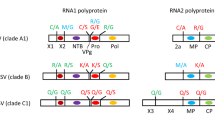Abstract
This chapter briefly summarizes instances in which proteolytic cleavage of viral structural proteins has been demonstrated to play a direct role in pathogenesis. It does not attempt to cover the extensive literature on the proteolytic processing of polyproteins, which is an essential step in virus replication, e.g., in picornaviruses or togaviruses, but has not been shown to be a determinant of pathogenesis other than in the broad sense that biosynthesis of viral components is required for viral replication. Emphasis is placed on those viruses for which cleavage by host proteases has been shown to be a major determinant of virulence, i.e., on paramyxoviruses and myxoviruses [1].
Access this chapter
Tax calculation will be finalised at checkout
Purchases are for personal use only
Preview
Unable to display preview. Download preview PDF.
Similar content being viewed by others
References
Choppin PW, Scheid A (1980) The role of viral glycoproteins in adsorption, penetration and pathogenicity of viruses. Rev Inf Diseases 2:40–61
Homma M, Ohuchi M (1973) Trypsin action on the growth of Sendai virus in tissue culture cells. III. Structural difference of Sendai virus grown in eggs and in tissue culture cells. J Virol 12:1457–1465
Scheid A, Choppin PW (1974) Identification of biological activities of paramyxovirus glycoproteins. Activation of cell fusion, hemolysis and infectivity by proteolytic cleavage of an inactive precursor protein of Sendai virus. Virology 57:475–490
Scheid A, Choppin PW (1977) Two disulfide-linked polypeptide chains constitute the active F protein of paramyxoviruses. Virology 80:54–66
Scheid A, Choppin PW (1976) Protease activation mutants of Sendai virus: Activation of biological properties by specific proteases. Virology 69:265–277
Gething M-J, White JM, Waterfield MD (1978) Purification of the fusion protein of Sendai virus: Analysis of the NH2-terminal sequence generated during precursor activation. Proc Natl Acad Sci USA 75:2737–2740
Richardson CD, Scheid A, Choppin PW (1980) Specific inhibition of paramyxovirus and myxovirus replication by oligopeptides with amino acid sequences similar to those at the N-termini of the F1 or HA2 viral polypeptides. Virology 105:205–222
Scheid A, Graves MC, Silver SM, Choppin PW (1978) Studies on the structure and functions of paramyxovirus glycoproteins. In Mahy BWJ, Barry RD (eds) Negative Strand Viruses and the Host Cell. Academic Press, London, p 181
Hsu M-C, Scheid A, Choppin PW (1981) Activation of the Sendai virus fusion protein (F) involves a conformational change with exposure of a new hydrophobic region. J Biol Chem 256:3357–3363
Richardson CD, Choppin PW (1983) Oligopeptides that specifically inhibit membrane fusion by paramyxoviruses: Studies on the site of action. Virology 131: in press
Scheid A, Choppin PW (1975) Activation of cell fusion and infectivity by proteolytic cleavage of a Sendai virus glycoprotein. In Reich E, Rifkin DB, Shaw E (eds) Proteases and Biological Control. Cold Spring Harbor Laboratory, New York, p 645
Nagai Y, Klenk H-D, Rott R (1976) Proteolytic cleavage of viral glycoproteins and its significance for the virulence of Newcastle disease virus. Virology 72:494–508
Silver SM, Scheid A, Choppin PW (1978) Loss on serial passage of rhesus monkey kidney cells of proteolytic activity required for Sendai virus activation. Infect Immun 20:235–241
Graves, MC, Silver SM, Choppin PW (1978) Measles virus polypeptide synthesis in infected cells. Virology 86:254–263
Holmes KV, Choppin PW (1966) On the role of the response of the cell membrane in determining virus virulence. Contrasting effects of the parainfluenza virus SV5 in two cell types. J Exp Med 124:501–520
Merz DC, Scheid A, Choppin PW (1980) Importance of antibody to the fusion glycoprotein of paramyxoviruses in the prevention of spread of infection. J Exp Med 151:275–288
Lazarowitz SG, Compans RW, Choppin PW (1971) Influenza virus structural and non-structural proteins in infected cells and their plasma membranes. Virology 46:830–843
Klenk H-D, Rott R, Orlich M, Bloedorn J (1975) Activation of influenza A viruses by trypsin treatment. Virology 68:426–439
Lazarowitz SG, Choppin PW (1975) Enhancement of the infectivity of influenza A and B viruses by proteolytic cleavage of the hemagglutinin polypeptide. Virology 68:440–454
Garten W, Bosch FX, Linder D, Rott R, Klenk H-D (1981). Proteolytic activation of the influenza virus hemagglutinin: The structure of the cleavage site and the enzyme involved in cleavage. Virology 115:361–374
Huang RTC, Rott R, Klenk H-D (1981) Influenza viruses cause hemolysis and fusion of cell. Virology 110:243–247
Lenard J, Miller DK (1981) pH-Dependent hemolysis by influenza, Semliki forest virus, and Sendai virus. Virology 110:479–482
Maeda T, Kawasaki K, Ohnishi S-I (1981) Interaction of influenza virus hemagglutinin with target membrane lipids is a key step in virus-induced hemolysis and cell fusion at pH 5.2. Proc Natl Acad Sci USA 78:4133–4137
White J, Matlin K, Helenius A (1981) Cell fusion by Semliki forest virus, influenza and vesicular stomatitis virus. J Cell Biol 89:674–679
Skehel JJ, Bayley PM, Brown EB, Martin SR, Waterfield MD, White JM, Wilson IA, Wiley DC (1982) Changes in the conformation of influenza virus hemagglutinin at the optimum of virus mediated membrane fusion. Proc Natl Acad Sci USA 79:968–972
Bosch, FX, Orlich M, Klenk H-D, Rott R (1979) The structure of the hemagglutinin, a determinant for the pathogenicity of influenza viruses. Virology 95:197–207
Author information
Authors and Affiliations
Editor information
Editors and Affiliations
Rights and permissions
Copyright information
© 1984 Springer-Verlag New York Inc.
About this chapter
Cite this chapter
Scheid, A., Choppin, P.W. (1984). Proteolytic Cleavage and Virus Pathogenesis. In: Notkins, A.L., Oldstone, M.B.A. (eds) Concepts in Viral Pathogenesis. Springer, New York, NY. https://doi.org/10.1007/978-1-4612-5250-4_4
Download citation
DOI: https://doi.org/10.1007/978-1-4612-5250-4_4
Publisher Name: Springer, New York, NY
Print ISBN: 978-1-4612-9756-7
Online ISBN: 978-1-4612-5250-4
eBook Packages: Springer Book Archive



